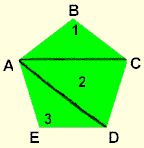Sum of Interior Angles of a Polygon
Sum of Interior Angles of a Polygon = 180(n – 2) (where n = number of sides)
Let’s investigate why this formula is true.
Start with vertex A and connect it to all other vertices (it is already connected to B and E by the sides of the figure).
 Three triangles are formed. The sum of the angles in each triangle contains 180°. The total number of degrees in all three triangles will be 3 times 180°. Consequently, the sum of the interior angles of a pentagon is:
Three triangles are formed. The sum of the angles in each triangle contains 180°. The total number of degrees in all three triangles will be 3 times 180°. Consequently, the sum of the interior angles of a pentagon is:
3 × 180° = 540°
Notice that a pentagon has 5 sides, and that 3 triangles were formed by connecting the vertices. The number of triangles formed will be 2 less than the number of sides.
This pattern is constant for all polygons. Representing the number of sides of a polygon as n, the number of triangles formed is (n – 2). Since each triangle contains 180°, the sum of the interior angles of a polygon is 180(n – 2).
Using the Formula
There are two types of problems that arise when using this formula:
1. Questions that ask you to find the number of degrees in the sum of the interior angles of a polygon.
2. Questions that ask you to find the number of sides of a polygon.
Hint: When working with the angle formulas for polygons, be sure to read each question carefully for clues as to which formula you will need to use to solve the problem. Look for the words that describe each kind of formula, such as the words sum, interior, each, exterior and degrees.
Example 1: Find the number of degrees in the sum of the interior angles of an octagon.
An octagon has 8 sides.
So n = 8. Using the formula from above,
180(n – 2) = 180(8 – 2) = 180(6) = 1080°
Example 2: How many sides does a polygon have if the sum of its interior angles is 720°?
Since, the number of degrees is given, set the formula above equal to 720°, and solve for n.
180(n – 2) = 720
n – 2 = 4
n = 6